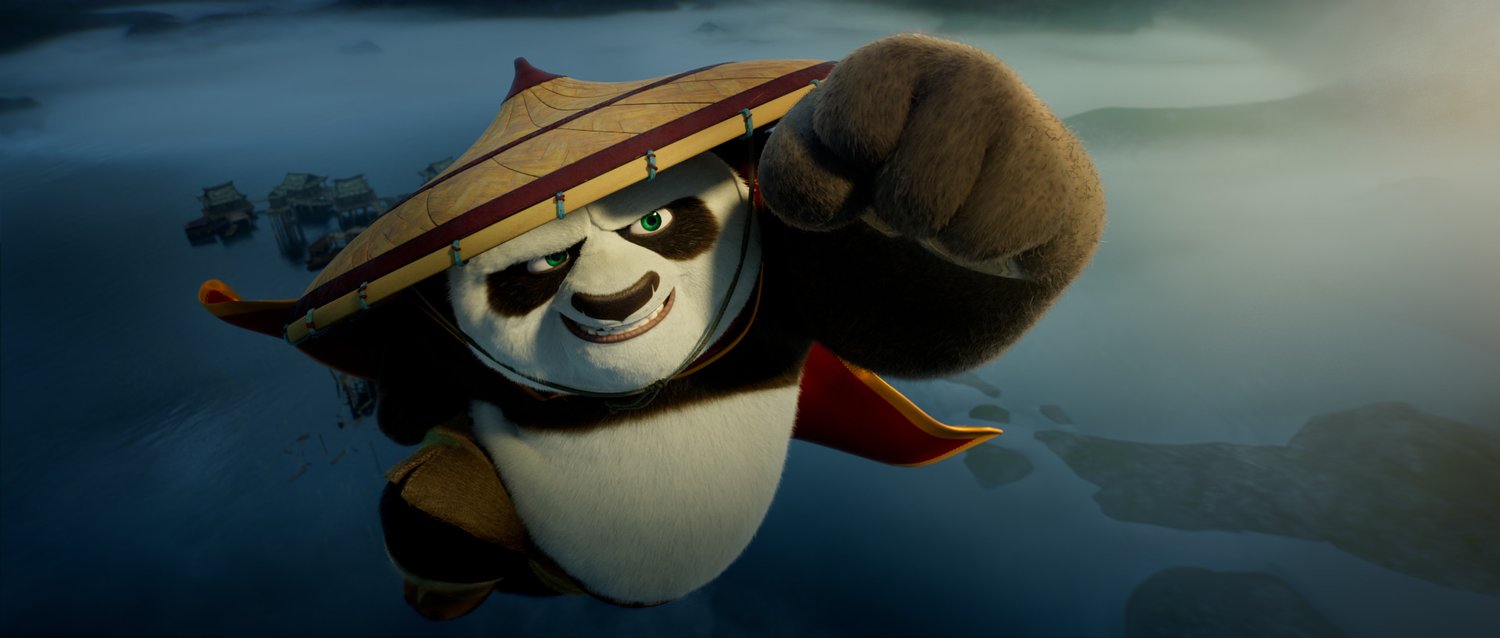Images courtesy of Dreamworks Animation
KUNG FU PANDA 4– 3 STARS
Not to sound entirely like the elementary school teacher I am by day, but triangles are said to be the strongest shape there is, where their three-sided geometric sturdiness evenly distributes any weight put upon them. Matching that precept of geometry over in movies, is that why film trilogies tend to be so strong? To tell a grand story, two movies isn’t enough while gunning for a fourth veers getting greedy. The latest franchise entry to test this axiom– and first of five high-profile fourth chapter movies coming in next year– is Kung Fu Panda 4.
LESSON #1: THE LOSING RECORD OF FOURTH MOVIES– Hollywood history has not been commonly kind to the fourth movies of a series. For every Mad Max: Fury Road, Harry Potter and the Goblet of Fire, Rocky IV, and Mission: Impossible – Ghost Protocol, you have a messy pile filled with Indiana Jones and the Crystal Skull, Toy Story 4, Pirates of the Caribbean: On Stranger Tides, The Bourne Legacy, Batman & Robin, Superman 4: The Quest of Peace, Jaws: The Revenge, Shrek Forever After, Alien Resurrection, Thor: Love and Thunder, Scream 4, and Vegas Vacation. The first two of those latter selections may have been financially successful but, narratively, undid two of the most perfect sendoff endings in cinema history for weak cash grabs. Some of those other listed losers after straight up killed entire franchises.
Kung Fu Panda 4 is indeed a mildly maligned fourth movie going up against the aforementioned poor track record. While Kung Fu Panda 3’s culmination involved Po becoming a Grand Master of kung-fu and chi across the Spirit and Mortal Realms, no one is ranking the 2016 movie next to Toy Story 3 or Indiana Jones and the Last Crusade in the pinnacle department, meaning a fourth movie should be reasonably welcomed without any sacrilegious blowback. Besides, the top condition for any positive acceptance rests on Kung Fu Panda 4 presenting a worthwhile new story that can justify its return to the multiplexes.
The quadquel opens on a returning Tai Lung (Ian McShane, still spitting gravel) attacking an iron mining camp of goats with the goal of absconding the collected ore for an unseen need. No one can make sense of this reappearance because the muscular snow leopard is supposed to be an incorporeal presence residing in the Spirit Realm. As it turns out, it is a shape-shifting sorceress named The Chameleon (voiced with the lower register of Oscar winner Viola Davis) who is wreaking havoc across the valley. She is out to capture the jade mystic staff possessed by Po (Black) as a means of tapping into the Spirit Realm to steal the kung fu movesets of defeated legends like Tai Lung for herself.
At the insistence of Master Shifu (a returning Dustin Hoffman, staying in low-level curmudgeon mode), Po’s own problem is the need to take “destiny’s next step” and transition from being the vaunted melee-based Dragon Warrior for the people into the wisdom-centered Spiritual Leader of the valley that Oogway was before the both of them. Accepting this change and promotion of sorts means Po must find a successor to the protector mantle of the Dragon Warrior. With the off-screen Furious Five away on their own missions, this replacement scouting is put on hold for Po to capture and neutralize The Chameleon.
Po picks up an inside informant of sorts for his investigative quest in the form of the thieving corsac fox Zhen (Awkwafina) from Juniper City. She’s his best lead on The Chameleon and a new buddy he’s trying to reform towards a more honest path to life. Po and Zhen soon enlist underworld help from the Sunda pangolin crime leader Han (Everything Everywhere All at Once Oscar winner Ke Huy Quan). At the same time and worried about their son, Po’s double-dads team of Li Shan (Bryan Cranston) and Mr. Ping (James Hong) follows close behind with offers to help. Within a villain who can look like anyone and steal their powers, Po needs all the help he can get.
For a movie starring a comedic character who can’t spit out a useful proverb, Kung Fu Panda 4 still tucks chestnuts in every chance it gets. The mantras of “inner peace” (including peace of one big panda’s stomach) and peach tree symbology carry over from the first three films. True to many other tales, you have a villain bent on acquiring power, a hero reluctant to take on a new responsibility, the eternal worry of parental figures, and characters who reflect on the past that has created their current present situations.
LESSON #2: BEING BRAVE VERSUS ACTING BRAVE– Among the many little lessons, Kung Fu Panda 4 puts two higher than the others. It starts with acting brave when one cannot fully be brave. Mr. Ping and Li Shan are working as unskilled fighting fathers entering the threat of conflict outside of their domestic comforts. They rely on a “fake-it-’til-you-make-it” energy to becomes stronger in support of their shared son. Cranston and Hong carry the largest B-plot of Kung Fu Panda 4, and it’s not really very compelling.
LESSON #3: IT’S NEVER TOO LATE TO DO THE RIGHT THING– The next higher emotional plane of Kung Fu Panda 4 leans on a quote often attributed to Nelson Mandela. This goal hits Zhen the most as she’s trying to shake her nefarious vices and her environment of violence to be a loved and trusted person to people who finally care about her. This arc would go over well if it wasn’t characterized by the wisecracker Awkwafina. She is her own unique comedienne and very good at voice work, but after eleven voice roles in the last eight years (with one more in 2024 and another in 2025), we’ve heard her same schtick too many times. Zhen is no different from the half-dozen ne’er-do-well characters she’s already done and with the same tone. One of the easiest casting trades would have been switching the underused Ke Huy Quan for Awkwafina. Give him the bigger and more challenging part trading barbs with Jack Black and Viola Davis.
Dreamworks Animation’s move to blow the dust off the Kung Fu Panda franchise for Kung Fu Panda 4 is a patient and strategic one. Jack Black is hot again after last year’s smash hit The Super Mario Bros. Movie, and it has been a healthy eight years since 2016’s Kung Fu Panda 3. A gap like that, not unlike the larger gaps between Toy Story and Puss in Boots movies, properly spreads entries into new micro-generations without being long-lost legacy sequels. Any kids from the 2016 target audience have likely aged out to become teenagers that will remember the series fondly enough to glance at the new one and maybe tag along with their little brothers and sisters for the new one. The studio knew what it was doing for a wider audience.
The bread and butter of the Kung Fu Panda animated franchise has been its remarkable balance of action and humor, sweetened with a touch of poignancy that has always lifted the movies up from being mindless pursuits. Series writers Jonathan Aibel and Glenn Berger (Monsters vs. Aliens, Trolls) have been here every kick and punch of the way. The duo has developed a shorthand for utilizing well-placed laughs to break up lulls while giving Jack Black room to riff. At the same time, the double-edged sword of an excess of villain monologues to stir up drama and relying on over-simple good vs. evil battles that aren’t very dynamic.
LESSON #4: LET JACK BLACK MAKE THESE MOVIES FOREVER– Despite its subpar story and the thinner ensemble of familiar voices, the stoutest barrel of panache and muscle holding up Kung Fu Panda 4 is Jack Black. His Po has a great introduction reply in the movie that cements his staying power and importance when Black’s voice announces he “was, is, and always will be the Dragon Warrior.” There’s no one else like him. For the fourth straight movie, his wide-eyed enthusiasm is contagious and influences every scene and supporting character his protagonist Po encounters. When he’s away and a subplot takes over, the fun factor drops sharply. Protect the treasure that is 54-year-old Jack Black. Let him do these movies until he’s old and gray, well, at least more than he already gloriously is.
LOGO DESIGNED BY MEENTS ILLUSTRATED (#1178)



